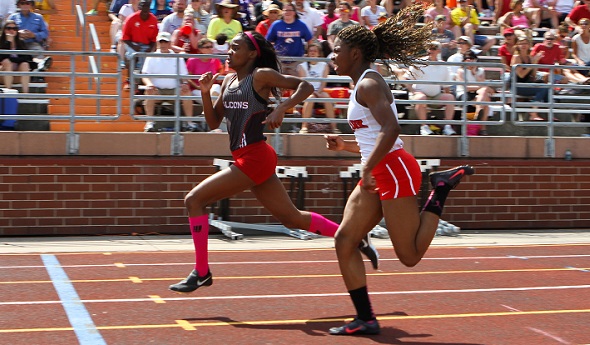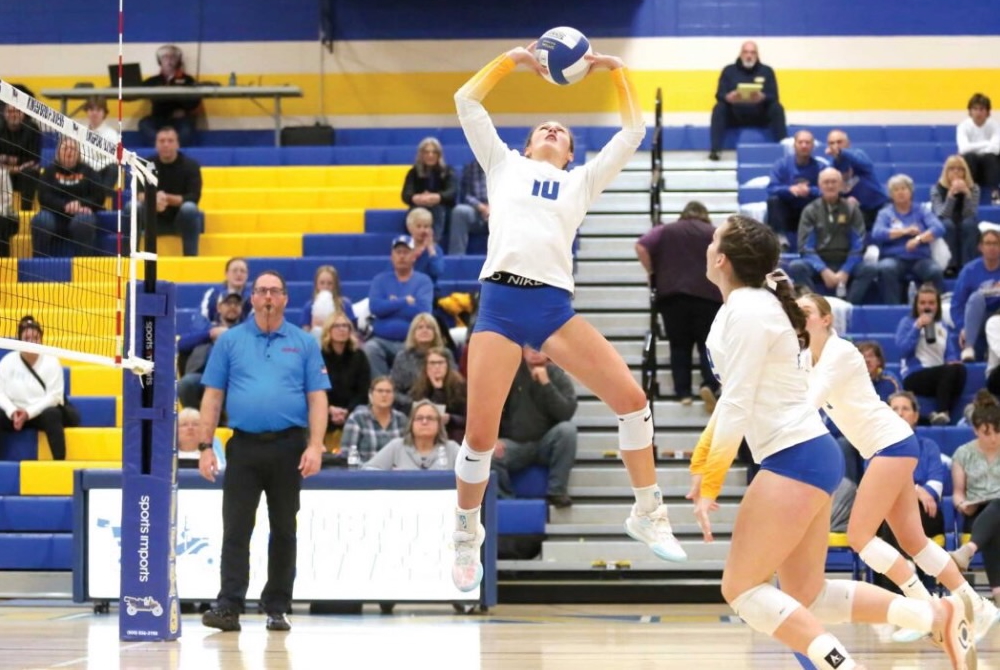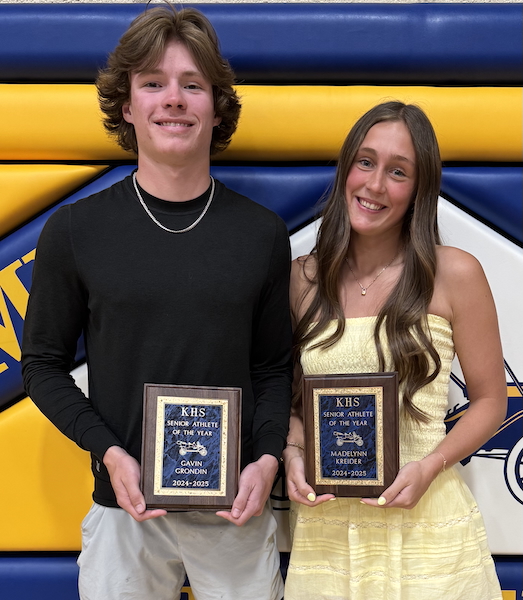
Classic Sprint, Oak Park Run Highlight D1
May 31, 2014
By Bill Khan
Special to Second Half
ROCKFORD — It was arguably the greatest high school girls 200-meter race ever in Michigan.
Sophomores Sekayi Bracey of East Kentwood and Anna Jefferson of Oak Park posted two of the seven fastest times in Michigan history at the MHSAA Lower Peninsula Division 1 Track and Field Finals on Saturday at Rockford High School.
Bracey edged Jefferson at the finish, crossing the line in 23.98 seconds. Jefferson was second in 24.03. Bracey's time is the fifth-fastest ever run in any Finals meet in Michigan, while Jefferson's is seventh.
Both the winner and runner-up enjoyed the duel, having rarely faced competition during the high school season.
"I love races like that," Jefferson said. "When I have her with me in the 200, I know she's going to make me work. I know I'm going to have a good race."
This wasn't the first duel between the two and, with two years of eligibility remaining for both of them, certainly won't be the last.
"I'm actually friends with her," Bracey said. "We've been running together since we were young."
Bracey and Jefferson were the individual stars of the meet, each winning three events and taking second in another.
Bracey won the long jump with a leap of 18 feet, 7.25 inches, the 100 in 11.88 seconds and the 200. She was on a second-place 400 relay team. Last year, Bracey was third in the long jump and won three events.
Jefferson greatest performance came in the 400, where her time of 53.50 seconds set an all-MHSAA Finals record, breaking the mark of 54.29 set by Southfield's Latipha Cross in 2011.
"When they said 53.50 officially, I screamed," said Jefferson, whose previous best was 54.30. "I was like, 'Oh, my gosh.' I went to pick up my teammate (fourth-place Johnyce Powell) and hug her but she was exhausted, so I had to give her a minute. I still couldn't believe I ran 53. I've been aiming for that for the past few years."
Jefferson was also on the winning 800 and 400 relay teams, helping Oak Park win the team championship in a rout, 92-50 over Northville. The 92 points are the most by a girls team in any division in seven years.
"I love my team," Jefferson said. "We've had a fantastic season compared to last year. We didn't have as many people, but we had high quality. Even though we're one of the smallest schools, we still have some of the top runners in the nation."
Oak Park will be a heavy favorite to win it all again next year, as there were no seniors among nine girls who scored points for the Knights. Scoring for Oak Park were freshmen Drew Coleman, Tamea McKelvy and Carlita Taylor; sophomores Jefferson, Lashae Bowens and Brianna Holloway; and juniors Jayla Fleming, Kailsi Latta-Thompson and Powell.
The Knights won three relays and were fourth in the 3,200 relay.
Birmingham Seaholm junior Audrey Belf, one of the nation's premier distance runners, ran an anchor leg of 2:08 in the 3,200 relay to help the Maples post the second-fastest time ever in an MHSAA Finals, 8:59.08. The other team members were Rachel Dadamio, Brooke Callaghan and Patty Girardot. Belf’s final leg was a personal best in the 800.
"When you get down to the end and your girls have done that much hard work, you don't want to mess it up," Belf said. "I know how much we wanted it. I wanted to finish it and make sure we got that victory."
Belf got a lengthy rest after that and dominated the 3,200, winning in 10:17.08. Northville senior Rachel Coleman, who won the 1,600 in 4:45.76, took second in 10:24.58. The top nine girls broke 10:46.
"I don't like running in the heat, but I made the best of it," Belf said. "I ran a little more conservatively."
Sterling Heights Stevenson senior Jailah Mason set an LP Division 1 record in the high jump, going 5-9.25.
Grosse Pointe South junior Ersula Farrow took aim at the Finals record in the 800 set last year by former teammate Hannah Meier. Farrow came up just short, finishing in 2:07.63 to win convincingly by 3.33 seconds.
"I wanted to go after the record," Farrow said. "I didn't get it this year, but I'm definitely going to try again next year. Hannah and (twin sister) Haley told me I was going to be the leader of the team. I did my best to be the leader of the team."
PHOTO: East Kentwood's Sekayi Bracey (left) and Oak Park's Anna Jefferson race toward the finish of the 200 on Saturday in Rockford. They posted two of the fastest times in the race in MHSAA Finals history. (Click to see more from RunMichigan.com.)

Kingsford's Kreider Prepared for Next Level After Finishing Stellar Flivvers Career
By
John Vrancic
Special for MHSAA.com
June 19, 2025
KINGSFORD — After completing a successful high school volleyball career, Maddy Kreider is ready to take the next step.
 The Kingsford senior is taking her talents to Michigan Tech, where she’s expected to continue primarily as a setter.
The Kingsford senior is taking her talents to Michigan Tech, where she’s expected to continue primarily as a setter.
“That will be a big step for sure, but it’ll be exciting being with the girls,” she said. “The girls are taller in college. It will definitely be an adjustment, physically and mentally. We’ll be traveling longer distances, and it’ll be a matter of improving the mental part of my game.”
Kreider was selected the Upper Peninsula’s Defensive Player of the Year her final two seasons after the U.P. Sportswriters and Sportscasters Association began voting for all-U.P. volleyball.
“That’s quite an accomplishment,” she said. “It’s a real honor playing with girls I grew up with. We had a great season.”
The 5-foot-8 setter was a four-year starter and two-year team captain at Kingsford, leading the Flivvers to three Division 2 District titles and back-to-back undefeated Great Northern Conference championships. She twice was named GNC Player of the Year.
She was also selected all-state first team in the fall and all-state second team in 2023, and all-region throughout her prep career. Her serving percentage also topped .900 throughout her four seasons on varsity.
 Last fall, the Flivvers reached the Regional Semifinal at Manistique where they dropped a 3-2 decision to Kingsley.
Last fall, the Flivvers reached the Regional Semifinal at Manistique where they dropped a 3-2 decision to Kingsley.
“I thought we’d get through,” Kreider said. “We came out lights out in the first two sets, then it was close in the last three.”
Also among the team’s highlights this past fall was a victory at Calumet, approximately 2½ weeks after dropping a 3-1 decision to the Copper Kings on Kingsford’s home floor.
“We wanted to play them,” Kreider said. “They’re a great bunch of girls to play against. They’ve been the measuring stick up here for many years. Winning on their floor was super exciting. We knew we had to play well just to be competitive. That was a great confidence builder for our group. We were definitely on a high going into the District.”
The Flivvers opened their postseason with a 3-1 triumph over Houghton, then defeated Escanaba in straight sets in the District Final.
Kreider will join Calumet senior Maddie Torola at MTU this fall. Torola, who recorded a season-high 19 kills in the four-set victory at Kingsford, helped the Copper Kings finish 29-5 and reach the Division 3 Regional Final at Sault Ste. Marie where they dropped a 3-2 decision to Traverse City St. Francis.
“It was fun playing against her in high school,” Kreider said. “It will be even more fun playing as teammates. It’ll be exciting to be playing on the same team.”
Both will be playing under new head coach Cindy Pindral at Tech. Both of Kreider’s parents played for the Huskies, her mother (and Kingsford varsity coach) Jaclynn volleyball from 1998-2002 and her father Jason basketball from 1997-2000.
Maddy Kreider recently earned an additional honor when she was selected Female Athlete of the Year for Kingsford’s Class of 2025. She recently completed a solid track & field season for the Flivvers.
At the U.P. Division 1 Finals, Kreider placed fourth in the 100-meter dash (13.2) and anchored the Flivvers to a third-place finish in the 800 relay (1:51.57) and fourth in the 400 (53.03) on their home track.
Kreider was named one of 32 MHSAA/Farm Bureau Insurance Scholar-Athlete Award winners this winter and plans to study exercise science and kinesiology at MTU.
 John Vrancic has covered high school sports in the Upper Peninsula since joining the Escanaba Daily Press staff in 1985. He is known most prominently across the peninsula for his extensive coverage of cross country and track & field that frequently appears in newspapers from the Wisconsin border to Lake Huron. He received the James Trethewey Award for Distinguished Service in 2015 from the Upper Peninsula Sportswriters and Sportscasters Association.
John Vrancic has covered high school sports in the Upper Peninsula since joining the Escanaba Daily Press staff in 1985. He is known most prominently across the peninsula for his extensive coverage of cross country and track & field that frequently appears in newspapers from the Wisconsin border to Lake Huron. He received the James Trethewey Award for Distinguished Service in 2015 from the Upper Peninsula Sportswriters and Sportscasters Association.
PHOTOS (Top) Kingsford’s Maddy Kreider sets for her teammates during a match last season. (Middle) Kreider, right, takes a photo with Kingsford’s Male Athlete of the Year Gavin Grondin. (Photos provided by the Kingsford athletic department.)

